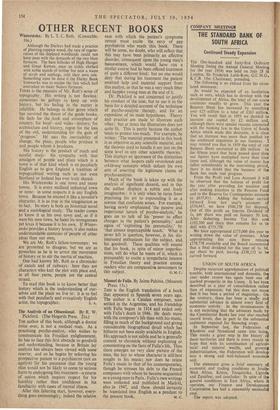OTHER RECENT BOOKS
Winterstoke. By L. T. C. Rolt. (Constable. 16s.) Although the Darleys had made a practice of planting coppice wood, the rate of regene- ration of the depleted woodlands could not keep pace with the demands of the two blast furnaces. The bare hillsides of High Hanger and Great Ketton, once so richly clothed with noble stands of timber but now a waste of scrub and saplings, told their own tale. Something must be done if the Darley Bank Ironworks was to escape the fate which had overtaken so many Sussex furnaces.
THERE is the measure of Mr. Rolt's sense of topography. His writing is not flawless: sometimes he gallops to keep up with history, but his feeling in the matter is infallible. He belongs in that genre which has survived the threat of the guide books. He feels for the ,look and atmosphere of country, for local—and wider—history, for architecture and history, regret for the loss of the old, understanding for the gain of 'progress.' Hd sees the inevitability of change, the place, people who produce it and people whom it produces.
His history is the product of much and careful study: his sympathy with that amalgam of people and place which is a town is of that kind which is so peculiarly English as to give England a tradition of topographical writing such ' as not even Scotland or Ireland has ever truly shared.
His Winterstoke is one town and many towns. It is every midland industrial town or none: in some respects it is any English town. Because he created it like a novelist's character, it is as true in the imagination as in fact. Its story is both an historical novel and a sociological study. The reader comes to know it as his own town and, as if it were•his own town, he hates its wrongnesses yet loves it because it is his own. If Winter- stoke provides a history lesson, it also makes understandable centuries of people of other ideas than our own.
We are Mr. Rolt's fellow-townsmen: we are permitted to disagree, but we are as powerless as he is to arrest the movement of history or to stir the inertia of reaction.
One had known Mr. Rolt as a chronicler of canals and of railways: here they are characters who knit the plot with place and, in all four yarns, people are the central strand.
To read this book is to know better that history which is the understanding of our- selves and the place we live in: it is to feel with that peculiarly and evocatively English artist, the topographer. J. A.


































 Previous page
Previous page